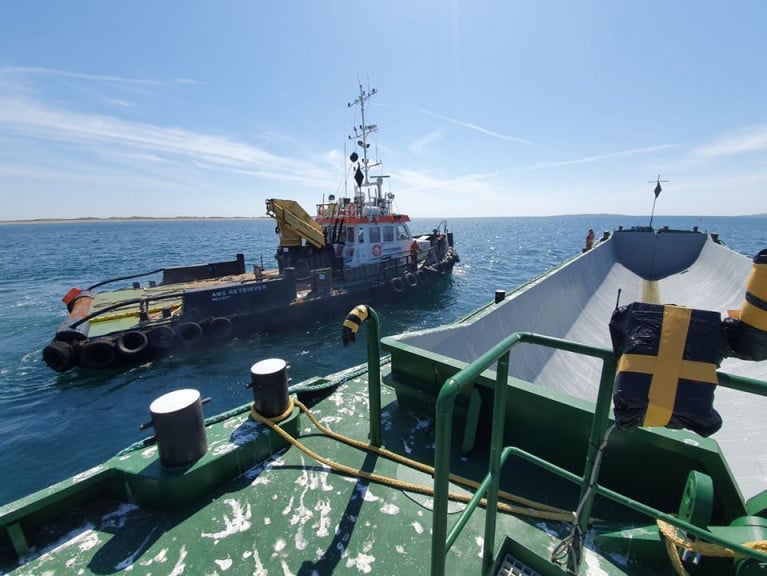Displaying items by tag: Towage News
Tug And Barge Project to Dredge Wexford's Kilmore Quay - Origin to Former Ferry Operator to France
A Wicklow Port based tug has completed a six day towage operation from Rotterdam, The Netherlands when it arrived off the coast of Kilmore Quay in Co. Wexford yesterday afternoon, writes Jehan Ashmore.
The 18.5 tonnes bollard pull AMS Retriever operated by Alpha Marine, the tug and workboat marine services company, deployed the Dutch shipyard built Damen Shoalbuster 2409 series tug to tow the split hopper-dredger barge B302.
It would appear the tug has at least served under two previous names, Marineco Akela with Leith in Scotland as the port of registry and as the C M Kurok when working in the Caspian Sea.
Both the Belfast registered tug and the Dutch barge will be assigned to work with Marine Specialists Ltd on the dredging of the south Wexford coast harbour which is to take place throughout this month. The shallow draft tug which has a crew of 5 will prove ideal option for such near coastal works.
Kilmore Quay is homeport to a fishing fleet and a 60-berth marina. In addition, the location over the years has been popular for leisure users, angling-hire craft and ferry boat trips out and to the nearby Saltees Islands.
As Afloat previously reported Alpha Marine's other tug, Husky was deployed last year to the former Stena Line ferryport at Dun Laoghaire Harbour having towed a barge laden with granite from Cornwall. This project was to replenish rock armour following Storm Emma of 2018 that mostly inflicted the East Pier and the project also involved use of a landing craft to convey heavy machinery by sea due to access issues.
Returning to the sunny south-east, where the O'Flaherty family has major fishing operations in the Wexford harbour which is homeport to their fleet of 10 beam white fish trawlers. They also have 3 twin riggers for prawns and a pelagic vessel. In addition to their fish wholesaler business, Saltees Fish has a cold storage plant located at the harbour.
Notably, the O'Flaherty's established Celtic Link Ferries in 2005, having acquired P&O Ferries Rosslare-Cherbourg route which they withdrew operations the previous year. In the deal, this included the route's ro-ro freight ferry European Diplomat (1978/16,776grt) with space for some 80 truck units and around the same capacity for passengers. This enabled the O'Flaherty's maintain their vital fishing exports to markets in mainland Europe.
CLF continued the business of providing freight hauliers on the Ireland-France link where truck drivers (including those for liverstock) were also part of the trade. Truck drivers on board the renamed Diplomat also shared dining facilities with a limited capacity of (motorist-only) passengers. This combination made the ferry operation unique on Ireland-France routes, with exception of Seatruck Ferries on their route network across the Irish Sea.
Celtic Link also had competitive rates for holidaymakers based on a 'no frills' basis compared to the more established ferry rivals, Irish Ferries and Brittany Ferries though they also have their 'économie' services soon to be operating from Rosslare this month.
When making a trip in 2009 as a guest of CLF, and notably as an exception having travelling as a 'foot' passenger which provided an opportunity to observe.On that related note the aft observation lounge however was not open on that particular crossing (see Ships Monthly, Nov.2009). This feature otherwise afforded excellent views was located at the highest passenger deck of the ship's superstructure and aft over the stern.
In addition on board was a plaque dedicated to then named Baltic Ferry, which served in the Falkland's Task Force in 1982 where the war involved RAF Harrier Jump-jets (VTOL) aircraft use the freight-ferry.
Unlike conventional ferries, Diplomat like many ro-ro freight ferries had the superstructure all located aft, with the uppermost vehicle deck exposed on the weather deck ahead of the bridge. The ship was built originally for Stena as one of their successful 'Searunner' series built in South Korea and for their charter market which saw these ships deployed worldwide on deep-sea routes.
After CLF ended its Irish career of Diplomat they chartered the ro-ro to the Carribbean. Replacement tonnage saw a succession of two Visentini-built passenger ropax's, Norman Voyager (of LD Lines short-lived Rosslare-Le Havre run) and Celtic Horizon (Ships Monthly, Feb.2013) which was renamed as outlined below.
CLF's (farewell) operations proved tempting as Stena Line made a bid to take over the Ireland-France route, which in 2014 became the company's first ever such direct route connecting mainland Europe. This saw the ropax renamed Stena Horizon and compete with the then presence of Irish Ferries running to Cherbourg in addition the summer-only Roscoff service (see, yesterday's story: Rosslare's Manager Says Europort can Take One Fifth of Dublin Port Activity).
It was at the 'Europort' in 2005, the first year of CLF operations, when a fleet of scallop trawlers based from Kilmore Quay held a fisheries related protest at the Wexford ferryport. The blockade prevented all ferries of the port, though when they departed the 'unaffected' Diplomat arrived afterwards.
As for Irish Ferries cruiseferry Isle of Inishmore, this ferry was less fortunate as not only was it subject to the blockade at the Irish ferryport but had the misfortune for a second time in the same year to be embroiled in a strike and siege incident (albeit in Pembroke Dock). On that occasion the ferry was centre-stage in the protracted and bitter Irish Ferries dispute over the replacement of Irish crew with lower-cost personnel from overeas.






























































